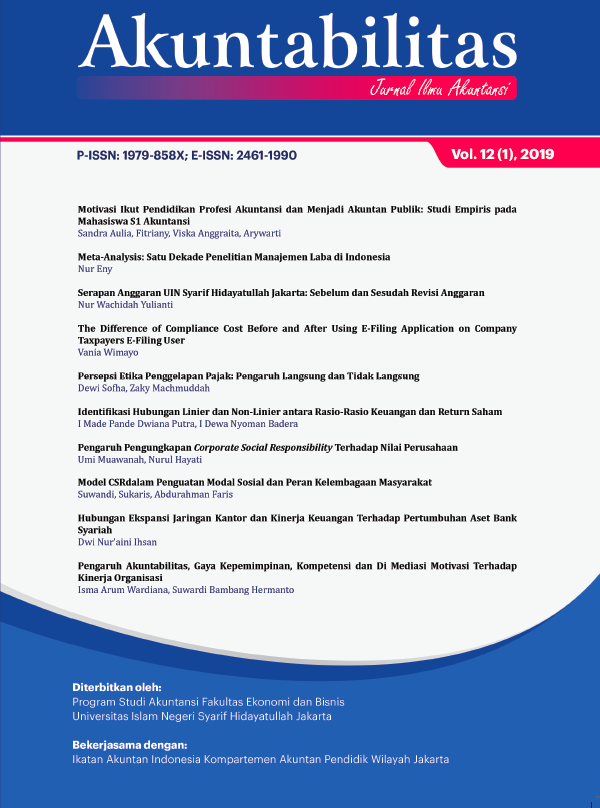Meta-Analysis: Satu Dekade Penelitian Manajemen Laba di Indonesia
DOI:
https://doi.org/10.15408/akt.v12i1.10617Keywords:
earnings management, corporate characteristics, information asymmetry, meta-analysisAbstract
This study aims to examine whether corporate characteristics and information asymmetry affects earnings management in Indonesia. This study use meta-analysis techniques approach with 35 samples from international and national accredited journals as well as Indonesian National Symposium of Accounting proceedings. Research results reinforce meta- analysis findings of previous studies where earnings management is done for different purposes. Management’s motivation to perform earnings management varies between opportunistic and efficient contract motives. Empirical evidence shows that corporate characteristics are predictors of earnings management. Cash flow from operations and information asymmetry significantly affect earnings management. This empirical evidence supports several previous meta-analysis in accounting field where moderator measurement variables has an effect on heterogeneity of research findings.References
Ali, S. Z., S. A. Butt., and A. Hasan. (2009). Corporate Governance and Earnings Management an Empirical Evidence Form Pakistani Listed Corporate. European Journal of Scientific Research. 26 (4). 624-638.
Ahmed, K., and J.K. Courtis. (1999). Associations between Corporate Characteristics and Disclosure Levels in Annual Reports: A Meta-analysis. British Accounting Review. 31 (1). 35–61.
Aussenegg, W., P. Inwinkl, and G. Schneider. (2009). Earnings Management and Accounting Standards in Europe. Proceedings of the 2009 MFA Annual Meeting.
Cheng C-H. 2006. Information Asymmetry and Earnings Management in Taiwanese Tech Industry. Corning journal 8. 99-112
Chtourou, S. M., J. Bedard, and L. Courteau. (2001). Corporate Governance and Earnings Management. Social Science Research Network (SSRN) http://paper.ssrn.com/abstract=275053.
Dalton, D.R, Catherine M. D., S. Trevi. C, and R. Roengpitya. (2003) Meta-analysis of Financial Peformance and Equity: Fusion or confusion?. Academy of Management Journal. 46. 13-26
Dechow, P., and R. G. Sloan, and A. P. Sweeney. (1995). Detecting Earnings Management. The Accounting Review. April. 70 (2). 193-225.
Dechow, P. M., D. J. Skinner. (2000). Earnings Management: Reconciling the Views of Accounting Academics, Practitioners, and Regulators. American Accounting Association Accounting Horizons. 14 (2). 235-250.
Dechow,.P., S. A. Richardson and A,I,Tuna. (2003). Why are Earnings Kinky? An Examination of the Earnings Management Explanation. Review of Accounting Studies. 8 (2-3). 355-384.
García-Meca, E., and J. P. Sánchez-Ballesta. (2009). Corporate Governance and Earnings Management: A Meta-Analysis. Corporate Governance: An International Review. 17(5). 594–610.
Gu, Z, and C-W. J. Lee. (2002). How Widespread is Earnings Management? The Intra-year Timing Evidence. Working Paper. Carnegie-Mellon University
Gu. Z, C. W. J. Lee and J. G. Rosett. (2005). What Determines the Variability of Accounting Accruals?. Review of Quantitative Finance & Accounting. 24(3). 313-334.
Healy, P.M. (1985). The Effect of Bonus Scheme on Accounting Decision. Journal of Accounting and Economics. 7 (1). 85-107.
Hunter, J. E. and F. L Schmidt. (2004). Methods of Meta-analysis: Correcting Error and Bias in Research Findings. (2end ed.). Thousand Oaks, CA: Sage.
Kothari. S. P., A. J. Leone, and C. E. Wasley. (2005). Performance Matched Discretionary Accrual Measures. Journal of Accounting and Economics. 39. 163-197.
Lipsey, M.W. and D.B. Wilson. (2001). Practical Meta-analysis. Applied Social Research Methods, 49. Sage Publications, Inc. California.
Lobo, G. J. and J. Zhou. (2001). Disclosure Quality and Earnings Management. Social Science Research Network Electronic Paper Collection
Lyons. L. C. (2000). Meta- Analysis: Methods of Accumulating Results Across Research Domains. Email Solomon @mnsinc.com.
McNichols. M. (2000). Research Design Issues in Earningss Management Studies. Journal of Accounting and Public Policy. 19. 313-345.
Mulford, C. W., and E. E. Comiskey. (2002). The Financial Numbers Game Detecting Creative Accounting Theory. New York: John Wiley and Sons, Inc.
Richardson. V. J. (2000). Information Asymmetry and Earnings Management: Some Evidence. Review of Quantitative Finance and Accoaunting. 15 (4). 325-347.
Shen C-H, and H-L Chih. (2005). Investor protection, prospect theory, and earnings management: An international comparison of the banking industry. Journal of Banking & Finance. 29. 2675– 2697
She. J. L. and M. Machfoedz. (1998). Faktor-Faktor yang Mempengaruhi Praktik Perataan Laba pada Perusahaan yang Terdaftar di Bursa Efek Jakarta. Jurnal Riset Akuntansi Indonesia. 1 (2). 174-191.
Sun L and S. Rath. (2009). An Empirical Analysis of Earnings Management in Australia. International Journal of Human and Social Sciences. 4 (14). 1069-1085.
Yangseon. K., L. Caixing, and S. R. Ghon. (2003). The Effect of Firm Size on Earnings Management. Available on-line rheesg@hawai.edu.
Zuhroh, D. (1996). Faktor-faktor yang Berpengaruh pada Tindakan Perataan laba pada Perusahaan Go Public di Indonesia. Universitas Gajah Mada. Yogyakarta. Tesis S2. Program Pasca Sarjana.

